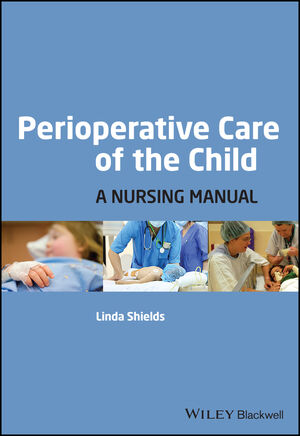Perioperative Care of the Child: A Nursing ManualISBN: 978-1-4051-5595-3
Paperback
288 pages
December 2009, Wiley-Blackwell
 |
||||||
Introduction
Acknowledgements
Abbreviations
1 The history of children’s perioperative care – Jeremy Jolley
Why history is important
What is perioperative nursing?
A brief history of perioperative nursing
An overview of the history of surgery
The development of perioperative nursing
Key discoveries in perioperative care
Early beginnings of surgery for children
The growth of paediatric surgery
Conclusion: perioperative nursing of children
References
2 The psychosocial care of children in the perioperative area – Linda Shields
Children’s perceptions of the operating theatre
The effect of hospitalisation on children
Models of care
The presence of parents
Play in the operating theatre suite
Emotional, social and spiritual needs of the patient
Conclusion
References
3 Care of the child in the operating room – Linda Shields and Ann Tanner
Preparation of children for theatre
Admission prior to surgery
Observation
Weight
Surgical history
Medical history
Medications
Body/site preparation
Pre-admission clinic
Emergency admission
Day of surgery admission
Reception in the operating suite
Registration on entrance to the OR
Fasting
Other things to check on admission to the OR
Safety of children in the operating theatre
Specific safety issues for children during induction
Post anaesthetic/post operative
Standing orders
Conclusion
References
4 Nursing care and management of children’s perioperative pain – Bernie Carter and Denise Jonas
Introduction
Preparing and teaching children and parents about pain
Agency, education and training of health care professionals
Assessing children’s pain
Core approaches to pain assessment
What tools to consider using with particular groups of children
Non-pharmacological interventions
Overview of pharmacological intervention
Routes of administration
Other local anaesthetic infusions
Discharge home
Conclusion
References
5 Surgical procedures on children – Linda Shields and Ann Tanner
Introduction
Common surgical procedures performed on children
Acknowledgement
References
6 Day surgery for children – Ann Tanner
Day procedure centres
Pre-admission preparation
Admission to the day procedure centre: preparations for surgery
Compartment syndrome
Admission to theatre
Ward stage recovery: post-operative care
Conclusion: support at home
References
7 Anaesthesia in children – Wendy McAlister
Introduction: What is anaesthesia?
The anaesthetic nurse
Children undergoing anaesthesia
Anaesthetic equipment
Airways
Anaesthesia
Analgesia
Patient preparation
Fasting
Premedication
Loose teeth and nail polish
Hearing aids and glasses
Jewellery
Preparation prior to patient arrival
Patient arrival in theatre
Induction
Rapid sequence induction
Fluids
Monitoring
Documentation
Anaesthetic emergencies
Anaphylaxis
Suxamethonium apnoea
Malignant hyperthermia
Emergence
Regional anaesthesia
References
8 The paediatric post-anaesthetic care unit – Eunice Hanisch
Introduction
In the PPACU
The post-operative environment
Oxygen delivery
Suction
Physiological assessment and management of the paediatric post-anaesthesia patient
A – Airway management and B – Breathing
Respiratory complications and nursing interventions
C – Circulation
Thermoregulation and temperature abnormalities
Post-operative nausea and vomiting
Pain management in the PPACU
Infection control
Fluid and electrolyte balance
Wounds and dressings
Patient positioning
Latex allergy
Children with epilepsy
Delayed emergence
Emergence delirium
Discharge of the patient from the PPACU
Psychological assessment
References
9 Fetal surgery – Roy Kimble
Introduction
History
The risks of fetal surgery
Fetal conditions amenable to fetal surgery
Ex utero intrapartum treatment (EXIT)
The future
References
10 Perioperative care of children with burns – Roy Kimble and Julie Mill
Introduction
History
Epidemiology of burns in children
A multidisciplinary service approach
Clinical assessment of burn severity
A – Airway
B – Breathing
C – Circulation
D – Neurological disability
E – Exposure with environment control
Classification of burn depth
Determination of burn depth
Laser Doppler scanning
Electrical burns
Chemical burns
Calculation of burn surface area
Management
Burn wound care
Preparation for theatre
Pain management via acute pain service
Post-operative care
Physiotherapy
Infection control
Toxic shock syndrome
Tetanus
Human immunodeficiency virus (HIV)-positive children
Scar management
Discharge planning
References
11 Paediatric transplantation – Rebecca Smith and Susan Tame
Introduction
Becoming an organ donor
Types of donation
Role of the transplant co-ordinator
Donor care and management
Making the donation request
Preoperative care of a potential paediatric donor
Perioperative care
Recipient management and care
Cardiothoracic organs
Immediate post-operative care
Liver
Kidneys
Small bowel, liver and multivisceral
Reducing the risk of rejection of the new organ
Longer-term post-operative care
The future
References
Further reading
12 The care of children having endoscopic procedures – Janet Roper and Linda Shields
Introduction
The perioperative nurse’s role
Preparing children for endoscopic procedures
Perioperative care
Service perspectives
Equipment for MIS and endoscopy
Conclusion
References
13 Ethical and legal issues in paediatric perioperative care – Linda Shields
Patients’ rights
Self-determination
Privacy
Confidentiality
Consent
Legal perspectives
Medical futility
Conclusion
References
Index



